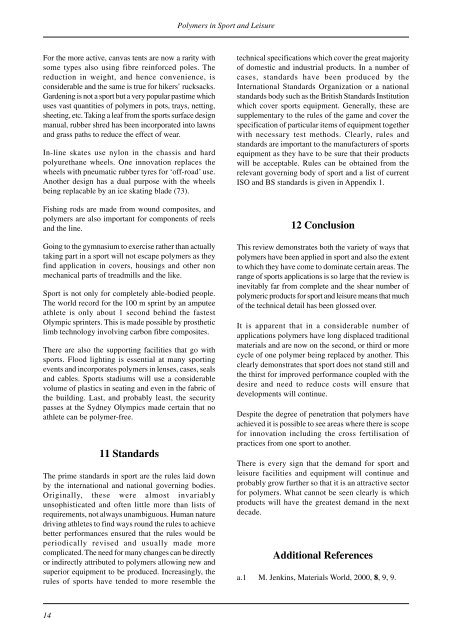Polymers in Sport and Leisure
Polymers in Sport and Leisure
Polymers in Sport and Leisure
You also want an ePaper? Increase the reach of your titles
YUMPU automatically turns print PDFs into web optimized ePapers that Google loves.
<strong>Polymers</strong> <strong>in</strong> <strong>Sport</strong> <strong>and</strong> <strong>Leisure</strong><br />
For the more active, canvas tents are now a rarity with<br />
some types also us<strong>in</strong>g fibre re<strong>in</strong>forced poles. The<br />
reduction <strong>in</strong> weight, <strong>and</strong> hence convenience, is<br />
considerable <strong>and</strong> the same is true for hikers’ rucksacks.<br />
Garden<strong>in</strong>g is not a sport but a very popular pastime which<br />
uses vast quantities of polymers <strong>in</strong> pots, trays, nett<strong>in</strong>g,<br />
sheet<strong>in</strong>g, etc. Tak<strong>in</strong>g a leaf from the sports surface design<br />
manual, rubber shred has been <strong>in</strong>corporated <strong>in</strong>to lawns<br />
<strong>and</strong> grass paths to reduce the effect of wear.<br />
In-l<strong>in</strong>e skates use nylon <strong>in</strong> the chassis <strong>and</strong> hard<br />
polyurethane wheels. One <strong>in</strong>novation replaces the<br />
wheels with pneumatic rubber tyres for ‘off-road’ use.<br />
Another design has a dual purpose with the wheels<br />
be<strong>in</strong>g replacable by an ice skat<strong>in</strong>g blade (73).<br />
Fish<strong>in</strong>g rods are made from wound composites, <strong>and</strong><br />
polymers are also important for components of reels<br />
<strong>and</strong> the l<strong>in</strong>e.<br />
Go<strong>in</strong>g to the gymnasium to exercise rather than actually<br />
tak<strong>in</strong>g part <strong>in</strong> a sport will not escape polymers as they<br />
f<strong>in</strong>d application <strong>in</strong> covers, hous<strong>in</strong>gs <strong>and</strong> other non<br />
mechanical parts of treadmills <strong>and</strong> the like.<br />
<strong>Sport</strong> is not only for completely able-bodied people.<br />
The world record for the 100 m spr<strong>in</strong>t by an amputee<br />
athlete is only about 1 second beh<strong>in</strong>d the fastest<br />
Olympic spr<strong>in</strong>ters. This is made possible by prosthetic<br />
limb technology <strong>in</strong>volv<strong>in</strong>g carbon fibre composites.<br />
There are also the support<strong>in</strong>g facilities that go with<br />
sports. Flood light<strong>in</strong>g is essential at many sport<strong>in</strong>g<br />
events <strong>and</strong> <strong>in</strong>corporates polymers <strong>in</strong> lenses, cases, seals<br />
<strong>and</strong> cables. <strong>Sport</strong>s stadiums will use a considerable<br />
volume of plastics <strong>in</strong> seat<strong>in</strong>g <strong>and</strong> even <strong>in</strong> the fabric of<br />
the build<strong>in</strong>g. Last, <strong>and</strong> probably least, the security<br />
passes at the Sydney Olympics made certa<strong>in</strong> that no<br />
athlete can be polymer-free.<br />
11 St<strong>and</strong>ards<br />
The prime st<strong>and</strong>ards <strong>in</strong> sport are the rules laid down<br />
by the <strong>in</strong>ternational <strong>and</strong> national govern<strong>in</strong>g bodies.<br />
Orig<strong>in</strong>ally, these were almost <strong>in</strong>variably<br />
unsophisticated <strong>and</strong> often little more than lists of<br />
requirements, not always unambiguous. Human nature<br />
driv<strong>in</strong>g athletes to f<strong>in</strong>d ways round the rules to achieve<br />
better performances ensured that the rules would be<br />
periodically revised <strong>and</strong> usually made more<br />
complicated. The need for many changes can be directly<br />
or <strong>in</strong>directly attributed to polymers allow<strong>in</strong>g new <strong>and</strong><br />
superior equipment to be produced. Increas<strong>in</strong>gly, the<br />
rules of sports have tended to more resemble the<br />
technical specifications which cover the great majority<br />
of domestic <strong>and</strong> <strong>in</strong>dustrial products. In a number of<br />
cases, st<strong>and</strong>ards have been produced by the<br />
International St<strong>and</strong>ards Organization or a national<br />
st<strong>and</strong>ards body such as the British St<strong>and</strong>ards Institution<br />
which cover sports equipment. Generally, these are<br />
supplementary to the rules of the game <strong>and</strong> cover the<br />
specification of particular items of equipment together<br />
with necessary test methods. Clearly, rules <strong>and</strong><br />
st<strong>and</strong>ards are important to the manufacturers of sports<br />
equipment as they have to be sure that their products<br />
will be acceptable. Rules can be obta<strong>in</strong>ed from the<br />
relevant govern<strong>in</strong>g body of sport <strong>and</strong> a list of current<br />
ISO <strong>and</strong> BS st<strong>and</strong>ards is given <strong>in</strong> Appendix 1.<br />
12 Conclusion<br />
This review demonstrates both the variety of ways that<br />
polymers have been applied <strong>in</strong> sport <strong>and</strong> also the extent<br />
to which they have come to dom<strong>in</strong>ate certa<strong>in</strong> areas. The<br />
range of sports applications is so large that the review is<br />
<strong>in</strong>evitably far from complete <strong>and</strong> the shear number of<br />
polymeric products for sport <strong>and</strong> leisure means that much<br />
of the technical detail has been glossed over.<br />
It is apparent that <strong>in</strong> a considerable number of<br />
applications polymers have long displaced traditional<br />
materials <strong>and</strong> are now on the second, or third or more<br />
cycle of one polymer be<strong>in</strong>g replaced by another. This<br />
clearly demonstrates that sport does not st<strong>and</strong> still <strong>and</strong><br />
the thirst for improved performance coupled with the<br />
desire <strong>and</strong> need to reduce costs will ensure that<br />
developments will cont<strong>in</strong>ue.<br />
Despite the degree of penetration that polymers have<br />
achieved it is possible to see areas where there is scope<br />
for <strong>in</strong>novation <strong>in</strong>clud<strong>in</strong>g the cross fertilisation of<br />
practices from one sport to another.<br />
There is every sign that the dem<strong>and</strong> for sport <strong>and</strong><br />
leisure facilities <strong>and</strong> equipment will cont<strong>in</strong>ue <strong>and</strong><br />
probably grow further so that it is an attractive sector<br />
for polymers. What cannot be seen clearly is which<br />
products will have the greatest dem<strong>and</strong> <strong>in</strong> the next<br />
decade.<br />
Additional References<br />
a.1 M. Jenk<strong>in</strong>s, Materials World, 2000, 8, 9, 9.<br />
14










